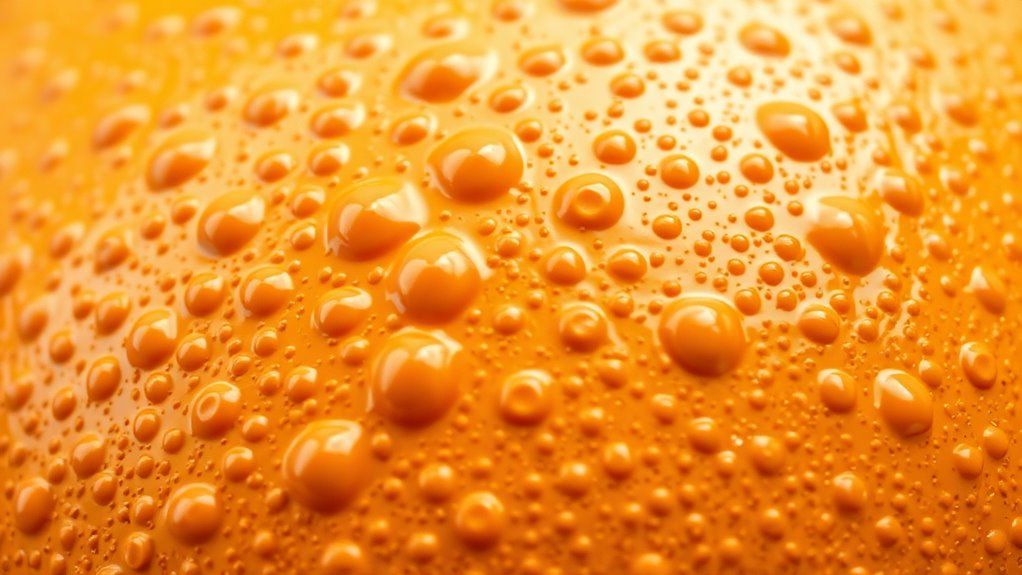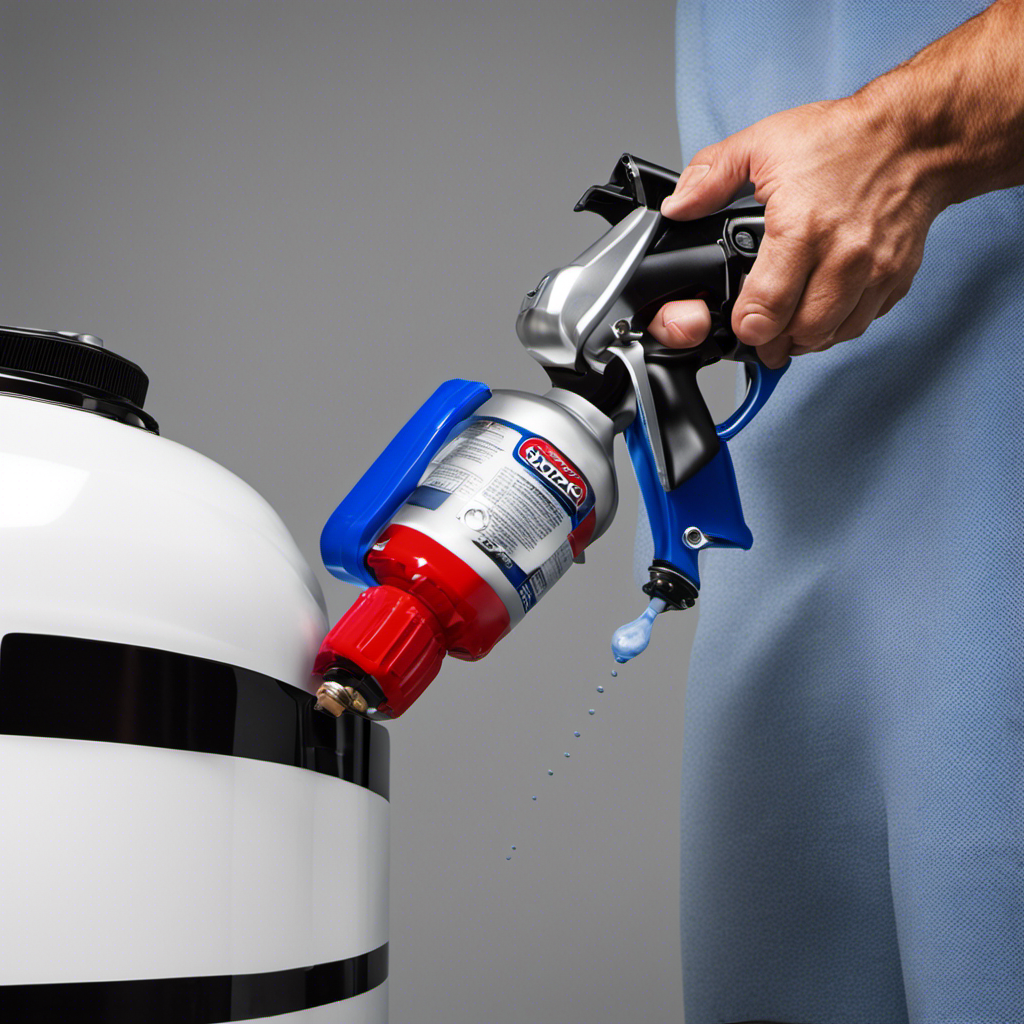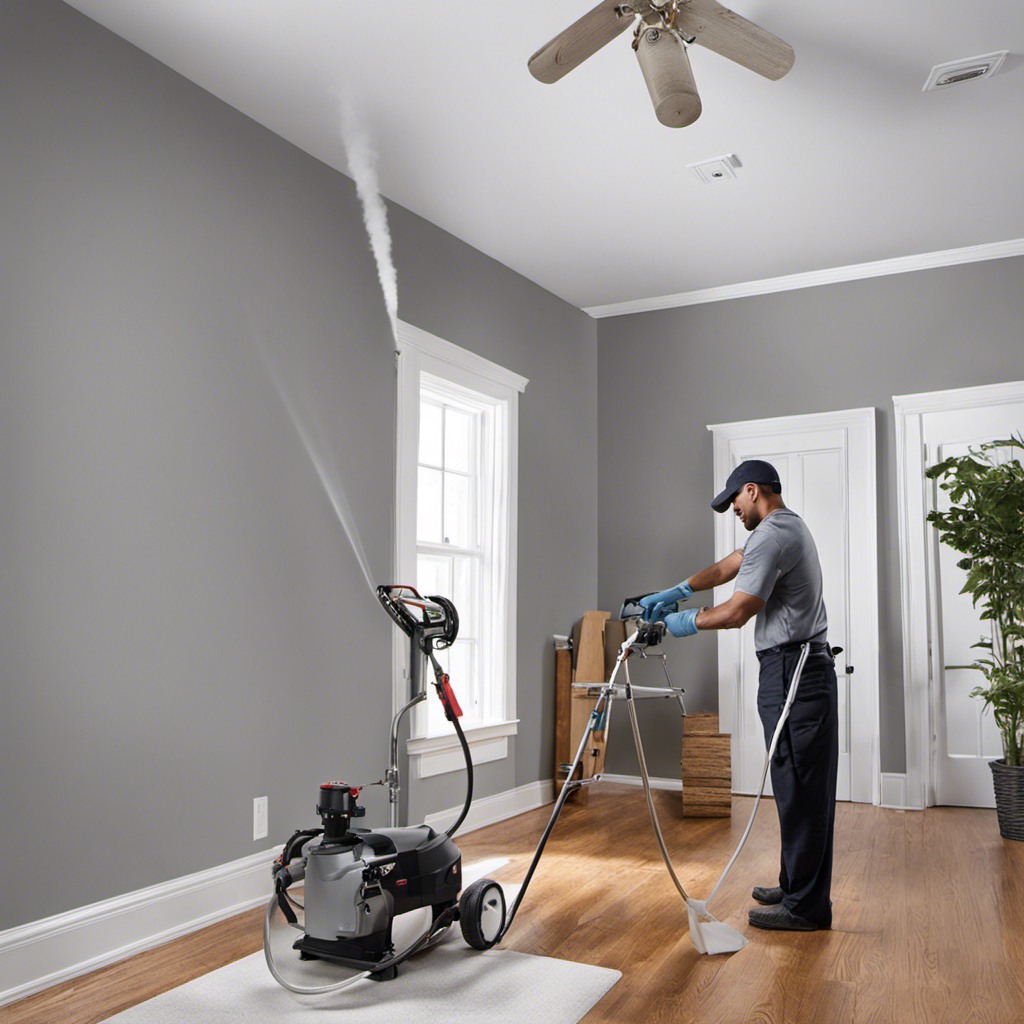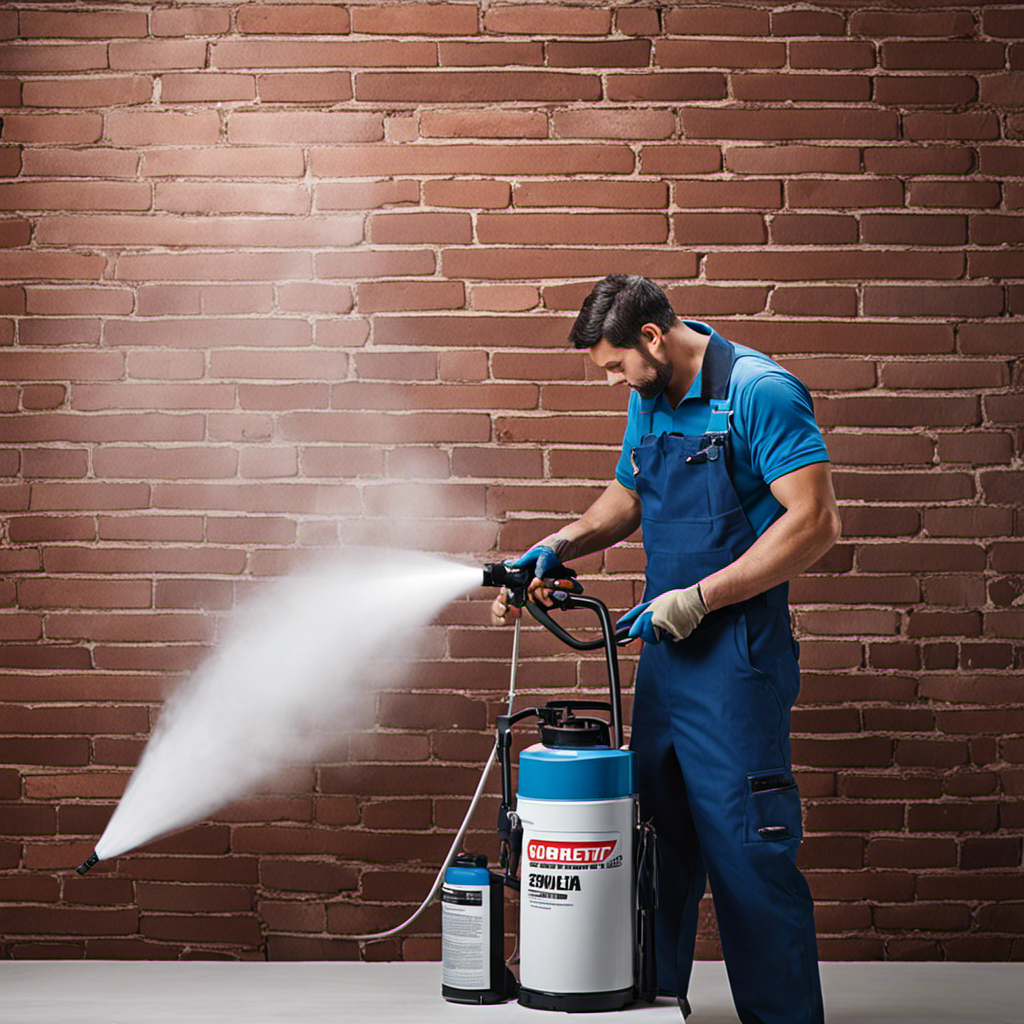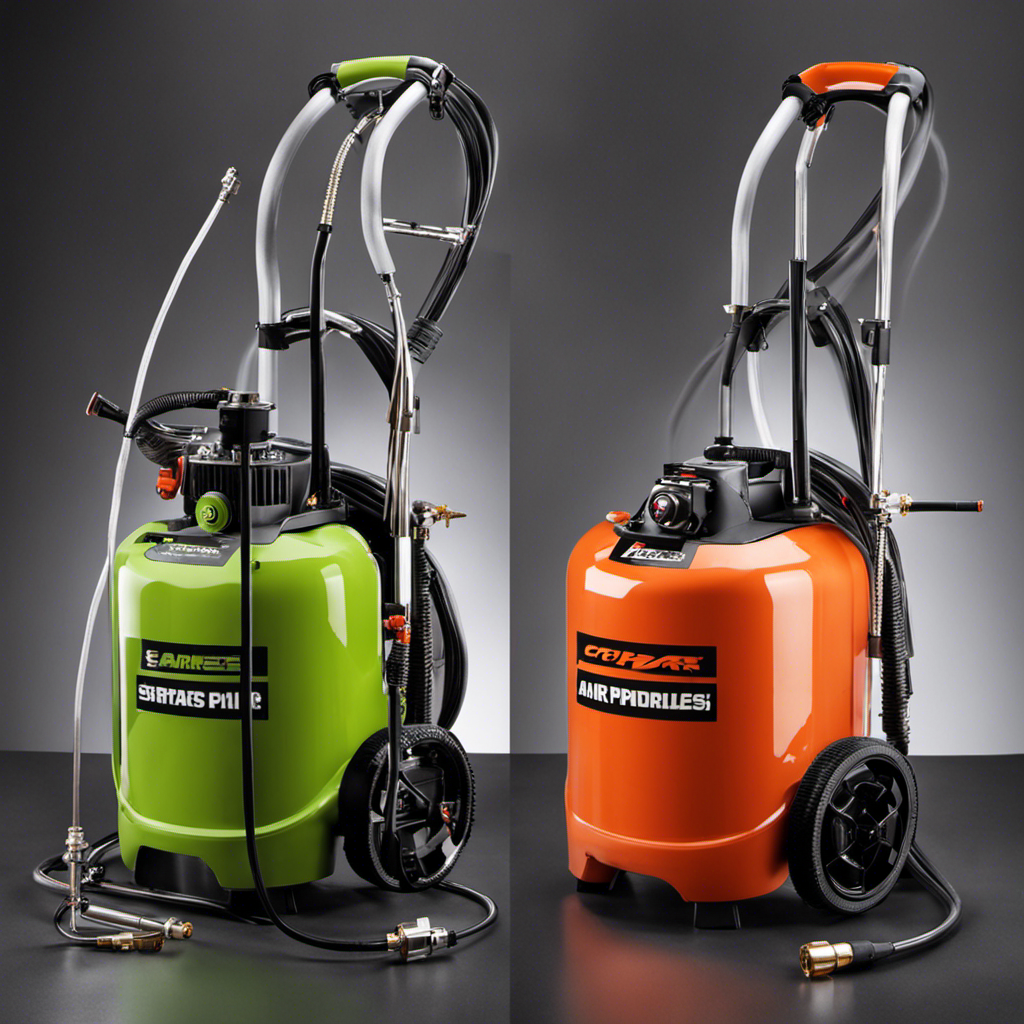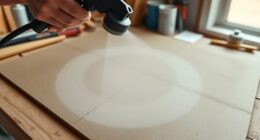If you get an orange peel or rough finish with your paint sprayer, it’s often caused by improper technique, incorrect equipment settings, or environmental factors. Make sure your spray gun tips and pressure are appropriate, clean and maintain your equipment regularly, and apply paint smoothly and consistently. Also, check that the paint is properly thinned and your environment isn’t too humid or windy. Keep these tips in mind, and you’ll improve your finish—more details follow.
Key Takeaways
- Improper spray gun distance, speed, or overlap causes uneven application leading to orange peel texture.
- Incorrect equipment settings like nozzle size, pressure, or flow rate result in poor atomization and rough finishes.
- Environmental factors such as humidity, temperature fluctuations, and airflow hinder proper drying and surface smoothness.
- Using wrong primer or unthinned paint can cause adhesion issues and surface irregularities.
- Regular equipment maintenance, correct spray techniques, and surface preparation help prevent rough finishes.
Understanding the Causes of Orange Peel and Rough Finishes

Orange peel and rough finishes often result from issues with spray technique or equipment settings. Poor brush techniques can cause uneven application, leading to surface texture problems. Additionally, selecting the wrong primer can contribute to rough finishes; a primer that doesn’t adhere well or dries unevenly creates a bumpy surface. When you rush or hold the spray gun too close, the paint can atomize improperly, causing a textured look. Using the right primer ensures a smooth base, reducing the chance of orange peel. Proper brush techniques—like consistent brush strokes and proper thinning—are also essential if you’re spot-priming or touching up. Paying attention to both primer selection and your application method helps you achieve a sleek, smooth finish and prevents rough textures. Incorporating proper application techniques can significantly improve the final surface quality, especially when combined with understanding spray gun adjustments and their impact on paint atomization. Mastering equipment calibration is crucial for controlling spray patterns and achieving a professional finish. Additionally, understanding the effects of paint viscosity can help prevent issues like orange peel or roughness by ensuring the paint flows smoothly.
The Impact of Sprayer Settings on Finish Quality

Sprayer settings play a crucial role in determining the quality of your finish, as improper adjustments can lead to uneven coverage or surface imperfections. Your spray pattern, pressure, and flow rate directly affect the surface appearance. Using correct brush techniques during prep and selecting the right primer also impact the final result. Adjusting the nozzle size and pressure ensures a smooth spray, reducing orange peel or rough textures. Here’s how different settings relate:
| Setting | Effect on Finish | Tips |
|---|---|---|
| Nozzle Size | Controls spray width and atomization | Use a size suited for your project |
| Pressure | Affects paint atomization and flow | Test to find ideal pressure |
| Flow Rate | Influences paint thickness on surface | Adjust for even coverage |
Proper sprayer settings combined with good brush techniques and primer selection yield the best finish. Additionally, understanding how atomization impacts paint finish can help optimize your sprayer’s performance and achieve a smoother surface. For optimal results, also consider sprayer maintenance to prevent issues like clogging that can affect finish quality.
How Spray Technique Affects Surface Texture

Your spray distance needs to stay consistent to avoid uneven texture, and maintaining proper overlap helps guarantee a smooth finish. Controlling your spray speed prevents drips and uneven spreading, which can ruin the surface. Paying attention to these techniques makes a noticeable difference in the final surface quality. Additionally, understanding Resources and Tools such as proper equipment and techniques can further enhance the quality of your spray finish.
Spray Distance Consistency
Maintaining a consistent spray distance is essential for achieving an even surface texture. When you keep the spray distance steady, your spray angle stays uniform, preventing uneven coverage that can cause orange peel or roughness. To do this, focus on holding the spray gun at the same distance from the surface throughout each pass. Adjust your nozzle size appropriately—smaller nozzles produce finer spray patterns, making it easier to control the distance and prevent overspray or runs. If you vary your distance, you risk uneven application, which can lead to texture issues. Practice maintaining a steady hand and consistent movement. Proper spray distance, combined with the right nozzle size and consistent spray angle, ensures a smooth, professional finish free of surface imperfections. Additionally, understanding how paint consistency impacts spray quality can help you achieve a more flawless finish.
Overlap and Spreading
Proper overlap and spreading of the spray are essential for achieving a smooth, uniform surface texture. If you don’t overlap your passes properly, you risk creating uneven spots, brush strokes, or roller marks that ruin the finish. Keep your spray pattern consistent, slightly overlapping each pass by about 50%, to avoid gaps or heavy spots. Moving too fast can cause uneven spreading, while moving too slow might lead to drips. Focus on maintaining a steady speed and keeping the spray distance consistent. Proper distribution ensures the paint flows smoothly over the surface, minimizing brush strokes and roller marks. This technique results in a professional-looking finish with a uniform texture, free from orange peel or rough patches. Additionally, understanding paint application techniques can further enhance your results by preventing common issues like orange peel or rough finish. Paying attention to surface preparation is also crucial to achieve the best possible surface quality before spraying. Incorporating consistent spray technique can help maintain an even coat and reduce imperfections during application, especially when combined with proper projector bulb maintenance practices. Using the right equipment and adjusting spray pressure accordingly can also significantly improve the final finish and prevent orange peel.
Spray Speed Control
Controlling your spray speed is essential because it directly influences the surface texture of your finish. Moving too fast can cause a rough, uneven surface, while moving too slowly may lead to drips and runs. To achieve a smooth, professional look, maintain a consistent spray speed that allows the paint to atomize properly. This consistency helps with color matching, ensuring even coverage across the surface. Your choice of primer selection also impacts how your spray speed affects the finish; a good primer promotes smoother application and reduces texture issues. Practice maintaining a steady speed, adjusting as needed for different surfaces and paint types. Proper spray speed control minimizes orange peel and rough finishes, giving you a sleek, flawless surface. Understanding industry trends can help you adapt your technique for optimal results. Additionally, being aware of the type of paint used can influence your spray technique and final surface quality. Maintaining proper surface preparation ensures better adhesion and a more uniform finish. Using the correct Glycolic Acid concentration can also improve surface smoothness, especially in areas that require exfoliation before painting.
The Role of Paint Consistency and Thinning

Have you ever wondered why your paint sprayer drags or sputters? The issue often comes down to paint consistency. If the paint is too thick, it can clog the nozzle or cause uneven spraying, leading to a rough finish. Proper thinning guarantees the paint flows smoothly, reducing orange peel or rough textures. Adjusting the solvent ratio is key—adding the right amount of solvent loosens the paint without making it too thin. Too thin, and it may run or sag; too thick, and it won’t spray evenly. Check the manufacturer’s recommended paint thickness and solvent ratio, and test the mixture before spraying. Achieving the right consistency helps your sprayer operate smoothly, delivering a professional-looking, even coat every time.
Environmental Factors Influencing Sprayer Results
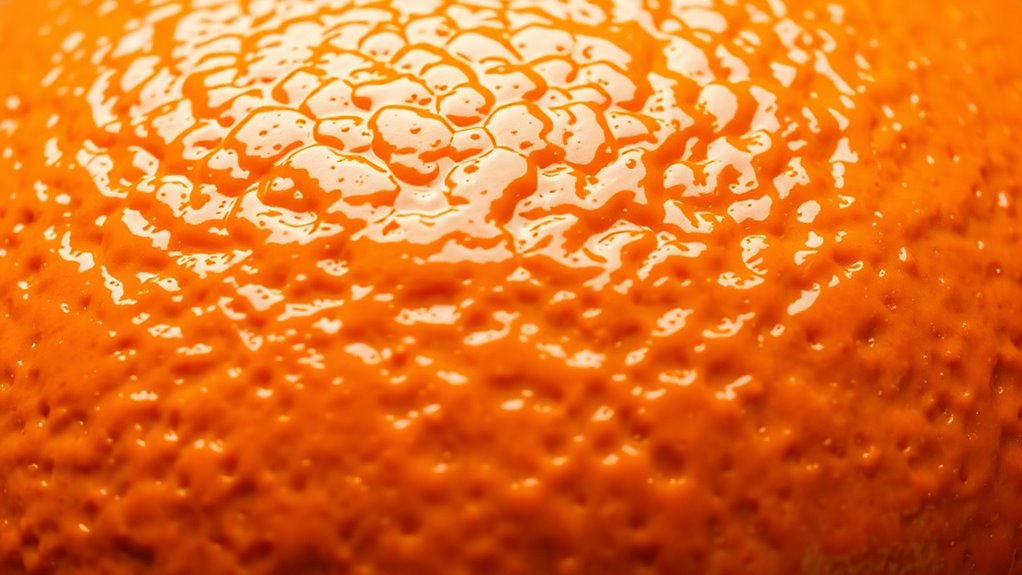
Environmental conditions can substantially affect your spray job. Humidity and moisture levels can cause paint to bubble or not adhere properly, while temperature fluctuations may lead to uneven drying. Wind and airflow can create overspray or uneven coats, so it’s essential to contemplate these factors before starting. Additionally, using appropriate tools like high-quality sprayers can help achieve a smoother finish despite environmental challenges. Properly calibrating your equipment and understanding airflow management are also crucial for optimal results in varying conditions. Monitoring environmental conditions can help you plan the best times to spray, ensuring consistent and professional finishes. Recognizing the impact of environmental factors on paint application can further assist in troubleshooting and improving your technique. Managing remote work routines effectively can also help in planning projects around favorable weather conditions, ensuring consistent results.
Humidity and Moisture
Humidity and moisture levels can profoundly impact the quality of your paint job when using a sprayer. Excess humidity slows down paint drying, increasing the risk of runs, drips, and a rough finish. High moisture content in the air can also cause the primer application to be uneven, as it may not adhere properly or dry correctly. When the environment is humid, paint can take longer to dry, leading to a less smooth surface and potential orange peel effects. Proper ventilation during spraying can help mitigate some of these issues. To improve results, avoid spraying in overly humid conditions or when moisture levels are high. Consider using a dehumidifier or waiting for drier weather. Properly managing humidity ensures better paint drying, a smooth finish, and a professional-looking result. Additionally, monitoring indoor air quality can help you determine the optimal conditions for painting. Awareness of humidity levels can help you plan your project more effectively and prevent undesirable outcomes. Incorporating advanced moisture control devices can further stabilize environmental conditions, leading to more consistent paint finishes. Using environmental monitoring tools can provide real-time data to optimize your painting conditions and achieve a superior finish.
Temperature Fluctuations
Temperature fluctuations can profoundly affect the outcome of your paint job with a sprayer. Sudden changes can cause paint to dry unevenly, leading to a rough or orange peel finish. To maintain proper color matching, guarantee the environment stays consistent; temperature shifts can alter how the paint cures, affecting the final hue. Good surface preparation is essential—make sure surfaces are at a stable temperature before spraying. If it’s too cold or hot, paint may dry too quickly or too slowly, causing texture issues. Keep your workspace within recommended temperature ranges, and avoid spraying during temperature swings. Consistency in temperature helps achieve a smooth, professional finish and ensures your color matches perfectly across the entire surface.
Wind and Airflow
Wind and airflow can substantially impact the quality of your paint job if you’re not careful. Strong winds can cause uneven spray patterns, leading to overspray or dry spots that create a rough, textured finish. Even gentle breezes can disrupt the flow of paint, causing unwanted brush strokes or roller marks to appear in your final coat. Proper airflow helps your sprayer apply a smooth, even layer, so avoid painting in windy conditions or near open windows and doors. If you notice roughness or inconsistencies, check for drafts or gusts that might be disrupting your spray. Controlling airflow ensures a consistent application, reducing the chances of orange peel or rough finishes caused by environmental interference. Always choose a sheltered, wind-free environment for ideal results.
Common Equipment Issues and Maintenance Tips
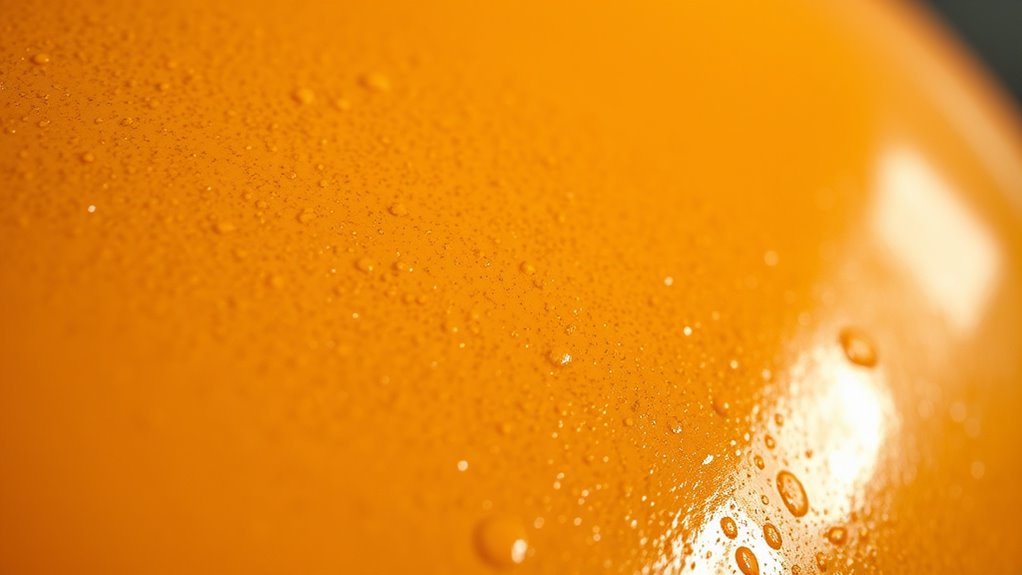
To keep your paint sprayer functioning effectively, it’s vital to identify and address common equipment issues early on. Poor spray patterns or rough finishes often stem from clogged nozzles or inconsistent pressure. Regularly check and clean your spray tip to prevent buildup that affects spray quality. Using proper brush techniques when cleaning can help avoid damage. Additionally, monitor your paint additives; too much or too little can clog filters or cause uneven flow. Make sure your air filters are clean, and inspect hoses for leaks or blockages. Lubricate moving parts as recommended by the manufacturer to prevent wear. Routine maintenance, like flushing the system after each use, keeps your sprayer in top condition and minimizes issues that lead to rough finishes or orange peel textures.
Practical Solutions to Achieve a Smooth, Flawless Surface

Achieving a smooth, flawless surface with your paint sprayer requires attention to technique and preparation. First, verify your equipment is clean and properly maintained to prevent uneven spray patterns. Adjust your sprayer’s pressure and spray distance to avoid uneven coatings that cause brush strokes or roller marks. Practice on a scrap surface to refine your technique, moving your sprayer in steady, overlapping passes. Keep your hand steady and maintain a consistent speed to prevent uneven texture. If you notice brush strokes or roller marks, lightly sand the surface with fine-grit sandpaper and reapply a thin, even coat. Using a high-quality, compatible paint or finish also helps achieve that smooth, professional look. Patience and proper technique are key to flawless results.
Frequently Asked Questions
Can Different Types of Paint Cause Orange Peel Regardless of Spray Technique?
Different types of paint can definitely cause orange peel, regardless of your spray technique. Paint formulation plays a big role—some paints are thicker or have slower drying times, making them harder to apply smoothly. If your application isn’t consistent, it can worsen the finish, leading to rough textures. To avoid this, choose the right paint for your project, maintain proper application consistency, and adjust your spraying method as needed for a smooth, professional look.
How Does Humidity Specifically Affect the Drying and Finish Quality?
Imagine humidity effects as a barrier that slows down your paint’s drying process, creating drying challenges. High humidity keeps moisture in the air, preventing your paint from curing properly, which can lead to a rough, uneven finish. This excess moisture interferes with the formation of a smooth surface, making it harder to achieve a flawless look. Controlling humidity levels during painting helps make certain of a cleaner, more professional finish.
Are There Specific Nozzle Sizes Recommended for Achieving a Smooth Finish?
For a smooth finish, you should focus on nozzle selection and spray pattern. Generally, a smaller nozzle size, like 1.2 or 1.4 mm, helps you achieve finer atomization. Adjust your nozzle to create a consistent spray pattern, ideally a wide, even fan. This guarantees even coverage and reduces orange peel. Experiment with different nozzle sizes to find what works best for your project and paint type, guaranteeing a sleek, smooth surface.
What Are the Best Practices for Cleaning Spray Equipment to Prevent Defects?
To prevent defects, you should follow proper cleaning protocols and prioritize equipment maintenance. After each use, disassemble your spray equipment and thoroughly clean all parts with appropriate solvents. Regularly inspect and lubricate moving parts to guarantee smooth operation. Keeping your equipment clean reduces paint buildup, prevents clogging, and maintains consistent spray patterns. Adopting these best practices helps you achieve a flawless finish every time.
How Do Temperature Fluctuations During Spraying Impact the Final Surface Texture?
Temperature fluctuations during spraying can considerably impact your final surface texture. When temperature isn’t stable, it affects spray consistency, causing uneven layers and rough finishes. You should aim for temperature stability in your workspace, ideally maintaining a consistent environment to guarantee smooth application. Sudden changes can cause paint to dry too quickly or too slowly, leading to undesirable textures like orange peel. Keeping conditions steady helps you achieve a flawless, professional-looking finish.
Conclusion
Just like a painter’s brush reveals their mastery, your sprayer’s performance shows your skill. By understanding and adjusting your technique, equipment, and environment, you can banish orange peel and rough finishes. Think of it as tuning a fine instrument—once you get it just right, your surface will sing with smooth, flawless perfection. Keep experimenting, stay patient, and soon your project will be as polished as a masterpiece.
A seasoned painter with over 15 years in the industry, Mike transitioned from hands-on painting projects to the digital world of paint sprayers. His extensive experience gives him a unique perspective on what users truly need when it comes to painting tools. As the Editor in Chief of Paint Sprayer Zone, Mike ensures that every piece of content not only provides value but also reflects the realities of painting — the challenges, the joys, and the intricate details.
